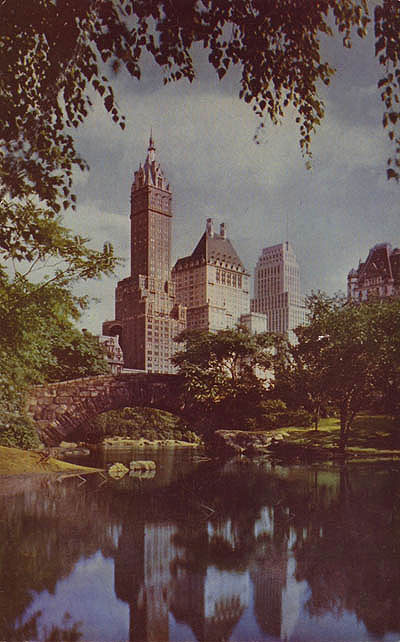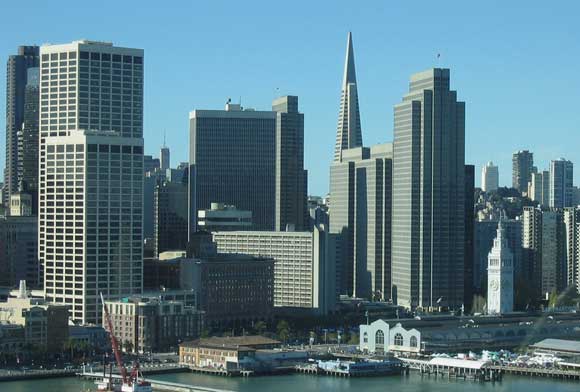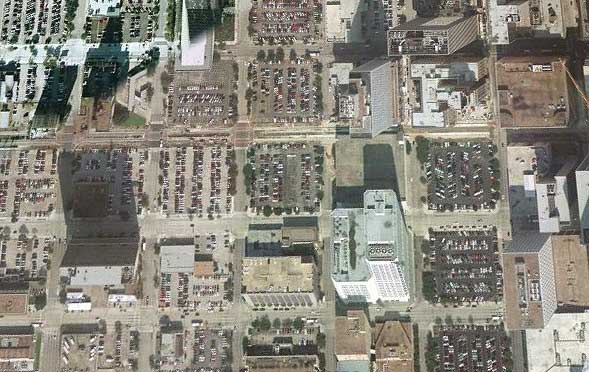

173 the art of the skyline
To Grady Clay, it 'connotes downtown derring-doers with an unlimited line of credit; the city as playground for the godly architect and the ambitious corporation' It has been a symbol of America since the word 'skyline' first appeared in 1896, in a picture caption to a view of Manhattan. Our penchant for verticality, made possible by structural steel and elevators, has made a great and particularly American contribution to architecture and design. But we weren't the first. Oddly enough, verticality is something we have in common with the medievals. The Italian mercantile cities grew some rather amazing skylines; altogether Italy had a dozen structures of over 300 ft. before 1500. That was something new in the world, in direct opposition to the horizontally-minded classical civilization, and the Baroque Europe that would follow. Business-minded cities just love to build towers; testosterone may be involved. Now, they're something no American town can do without. Even cities that never cared for them in the past, such as St. Louis and Washington, feel compelled to join in, though Washington's are all across the river in Virginia, due to Daniel Burnham's height limit. Philadelphia had a height limit too; no building could be taller than the brim of Billy Penn's hat, on the statue high atop the City Hall tower. The result of that was a downtown skyline that looked like one enormous gray box, full of office buildings all about 500ft. The limit disappeared with the building of One Liberty Place in 1986, and already, Philadelphia has a handsome skyline that most people would recognize from a photo. In most cities, Americans gave some care to skylines even before there were skyscrapers. Old photos will show you remarkably medieval-looking examples in St. Paul or Frankfort, Kentucky (which still had one when I saw it in the 80's), and many other towns, especially those where the German influence was strong. In Milwaukee, a German mayor and German architect collaborated on America's first skyscraper city hall, in 1893. Almost as soon as the skyscraper was invented, owners pressed their architects to give it a fancy top, something that would be an embellishment for the city and good advertising for the business that built it. Frank Woolworth's advisors had tried to convince him that all that office space in his giant Woolworth Building would be unrentable. But the master of retailing understood the extra value to come from using the building as a corporate symbol, and he was right. An early PR man named S. Parkes Cadman, who would later become one of the first radio preachers, proclaimed it the 'Cathedral of Commerce'. The building acquired cachet, and filled up rapidly; its advertising dividend lasted for decades, as Woolworth plastered images of his tower on half the things he sold, from needle packets to the backs of dominoes. A further lurch into monumentality for business' sake came with the Chrysler Building, spangled with stainless steel hubcaps and hood ornaments, just like the advanced 'Airflow' cars the company was introducing at the time. Though both buildings suffered derision from the critics in their day, everyone today agrees they are masterpieces-two wonderful creations that appeared from the basest of commercial motives. 
San Francisco skyline: this character
assassination of a great city was effected not so much by the arrogant
childishness of William Pereira's Transamerica pyramid, but the ranks
of gray boxes around it.
The purest of motives, in architecture's fit of high seriousness, proved themselves a failure in the 60's and 70's. As in so many other things, so we can see the decadence of the skyscraper in the postwar decades, or more accurately, the decadence of the American businessman, in an era when building had been reduced to nothing more than an exercise in the maximization of profits. While Sears was losing market share everywhere, the company exerted itself to built the tallest tower in the world in Chicago, and because the design was so mind-numbingly dull they never sold so much as a handkerchief from it. Downtowns everywhere filled up with large bulky boxes, like appliances stacked in the back of a warehouse. Many of the great skyline compositions sculpted in the 20's were wrecked by such a blossoming of boxes. The downtown New York skyline of old had been perfect, inspiring in its way, grouped around three needle-like towers around Wall Street, each nearly a thousand feet in height, each completed around 1930. It is impossible to think that both the architects and their financier clients did not give some consideration to the effect on the skyline when they built. When the next building boom started, in the 60's, the fecklessness of a new generation of businessmen coincided with the 1961 zoning reform, which replaced the old setback laws. The old composition was ruined, as the tip of Manhattan rapidly turned into a single flat-topped mass. The boxes spoiled the skylines of young and prosperous cities everywhere; we would dare anyone to tell apart those of Denver, Phoenix, Seattle, Dallas, Calgary or Edmonton. San Francisco and Toronto are just as bad, though two frivolous buildings, the triangular Transamerica Building and the 1815-ft. CN Tower television mast, would give them away. Today, the box is already a dinosaur. Revulsion against such architecture has become well-nigh universal, and there are plenty of flat-topped, undistinguished buildings from the 60's and 70's boom that have declined to class B or even C status. Some, in towns with slack economies, are already empty, and no doubt we will see a few demolished soon. Tastes have definitely changed, and concern for the skyline may well be making a comeback. Atlanta's new business district in Uptown has sprouted an entirely new grouping of urbane, Deco-influenced towers, giving the city one of the most elegant compositions in America. Atlanta has morphed into a double skyline, as Manhattan did, or Boston, with its collections of buildings downtown and at Copley Square. What is more, cities where large concentrations of tall buildings steal sunlight and air from their neighbors are beginning to address the problem, just as New York did in 1916. Right now, San Francisco has the most sophisticated approach. Their way, designed after citizen protests and referenda, protects the sunlight in parks and other public places, though for that city it may well be too late. It only takes a few modest buildings to make a really memorable skyline, as proved by such towns as Providence and Cincinnati. On the other hand too many can ruin it forever if city art commissions are not vigilant, and architects and developers do not consider the relation of their buildings to those around it. Height, surprisingly, is not the most important factor; composition is. An exciting skyline can be created from a few 200-ft buildings just as easily as with thousand-footers; cities like Miami and Kansas City looked much better in the 50's, before they were covered in boxes. And conversely, a skyline that already is effective can be ruined forever by the introduction of one outsized tower that makes its neighbors seem insignificant. Kids in Columbus, Ohio neatly apprised the situation after the completion of the city's first skyscraper, the 555-ft. Lincoln-LeVeque tower in 1927. For decades, Columbus was the 'city with the hard-on'. Some people think that monumental downtowns and their skylines are already obsolete. The ratio between office space in the center and the suburbs is tipping everywhere in favor of peripheral locations. Many large firms have a decreased need for large office staffs due to telecommuting, the farming out of back-office work to the suburbs or to India. After 9-11, the media chatter had it that our days of tower-building were over, that everyone would want to flee them and hide in some suburban office park where Osama could never find them. If the same testosterone rules of capitalism still apply, the roster of the world's tallest buildings suggests America is past its prime. At writing, ten of top twelve are in Asia: two in Malaysia, one in Dubai, one in Taiwan and the other six in China. Look at the market for evidence to support these predictions, though, and you will look in vain. The 90's brought a new boom in skyscraper construction. Despite telecommuting, it seems clear that people will always need face-to-face contact and the services and amenities urban centers provide. The experience of the computer industry in California suggests that demand for office space might well increase: they have experienced a doubling of space requirements with only a 10-20% increase in employees, as offices need more room for computer equipment, and larger and fancier reception areas for clients. Some downtown business districts may well have 'topped out', at least for the moment. Others will continue to expand. But there is much more to the art of the skyline than just downtowns. The sight of towers and steeples rising over the trees is an elegant, very American kind of cityscape seen in many parts of town: in uptown districts, waterfront apartment strips, or suburban edge cities and resorts, like the hotels in Miami Beach. In our increasingly multipolar cities, this will continue; we'll have not just one skyline, but many, large and small, just as Houston and Dallas and Los Angeles do today. We have spent a long time discussing something that at bottom is relatively trivial. All along, only New York, Chicago and a select few other cities have known the kind of pressure on central land values that make skyscrapers financially logical. Everywhere else they are largely decoration, and prestige. Some of them took decades to fill, and probably most of them in smaller cities lose money in the long run. We build commercial skylines not of necessity, but as a symbol, the image of our cities that we wish the world to see. It may be we spent a little too much on them, that we concentrate so much effort on the one dimension of verticality, to the detriment of everything else that makes a city memorable. It's a chilling thought, walking the spectral vacuum of downtown Houston. You're surrounded by a skyline-and nothing else, as if it were only a stage prop. Not a real city, but a sign to replace a city that has been annihilated. Perhaps there is a point at which the skyline becomes toxic. 
previous:
165 conservative surgery |
|

|